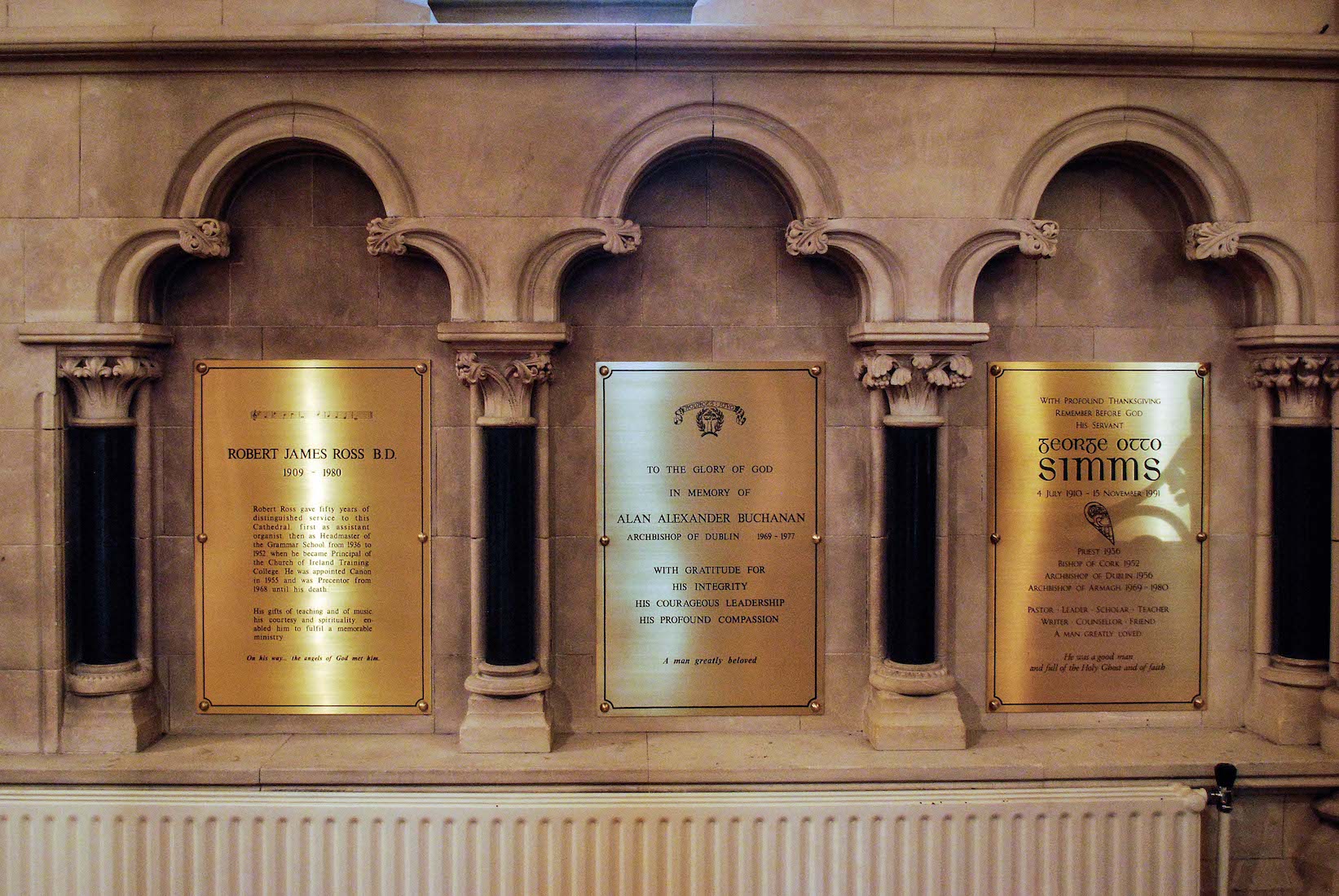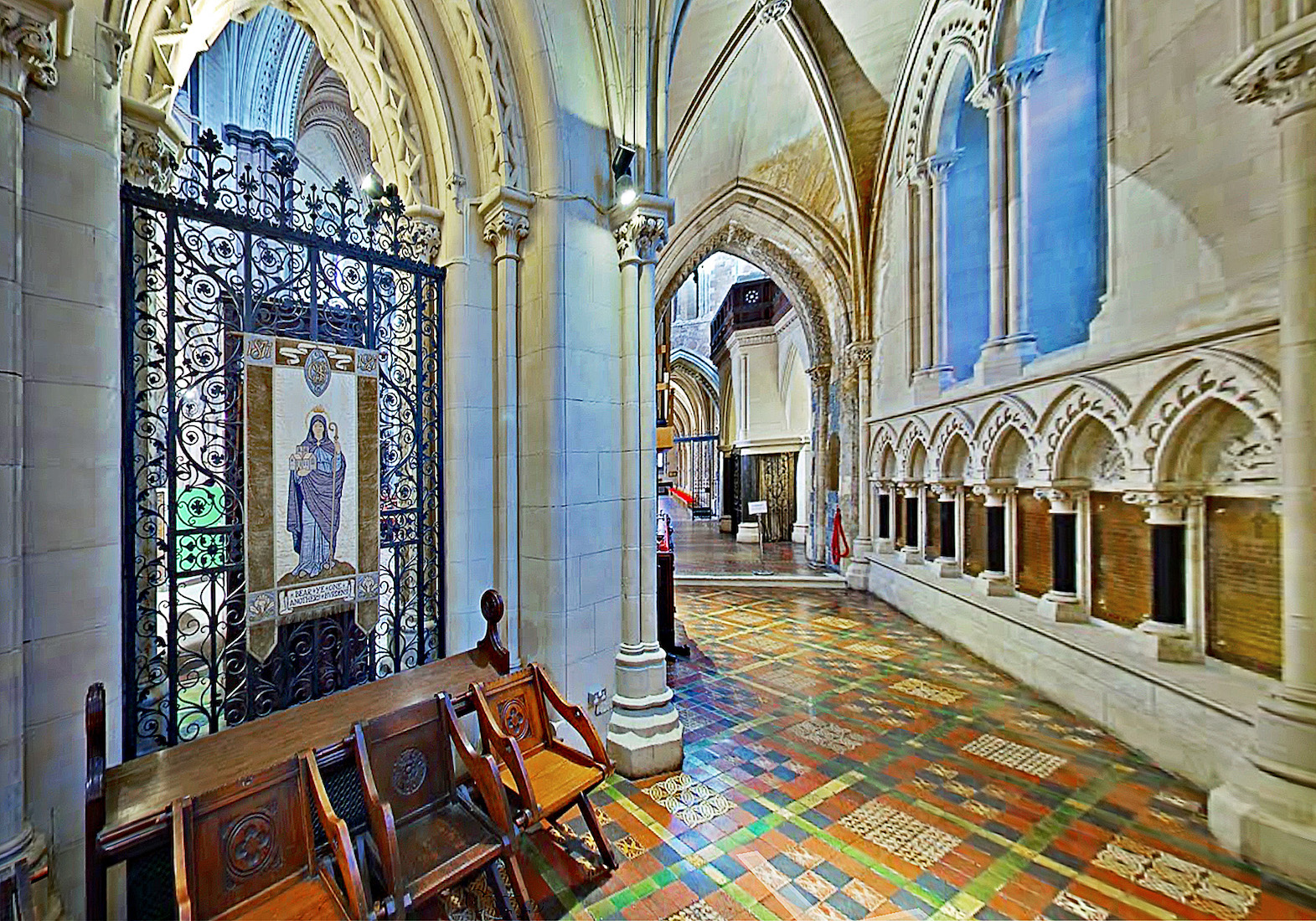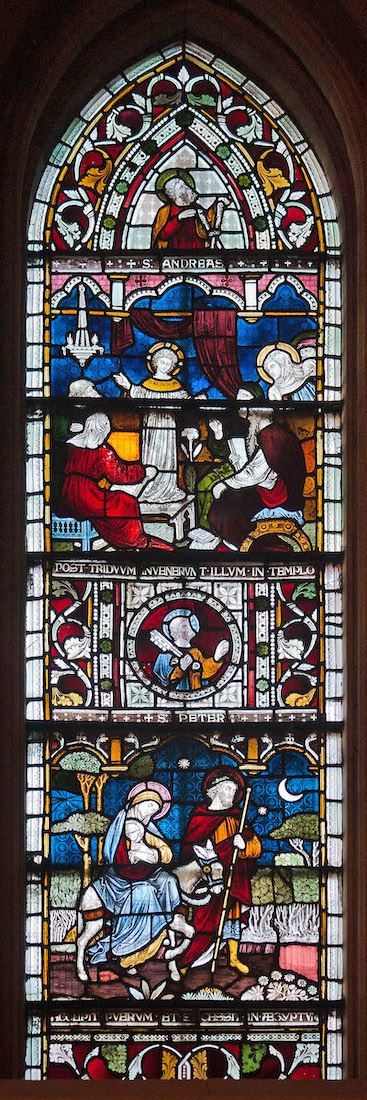

The pulpit is much more interesting. It has ornate carvings of the four evangelists, was designed in the 1870s by the architect George Edmund Street, and executed by Thomas Earp of London. •• Notice the iron screen gates behind the pulpit which lead through to the North ambulatory. INDEX
42. TO THE PEACE CHAPEL LM

We go through the iron gates into the ambulatory, and to our left are further iron gates leading to the Peace Chapel. This chapel occupies the shallow North transept. There is the possibility of some naming confusion here. This location for the Peace Chapel is indicated in current Cathedral literature, but in the past the Chapel of St Laud has also borne this name.
43. PEACE CHAPEL LM
Entering the Peace Chapel we turn to our right, facing the altar towards the East. On the altar are two candles and St Andrei Rublev’s famous icon ‘Hospitality of Abraham’. This icon is ofter interpreted as depicting the Trinity. The chapel is certainly very peaceful.
44. LOOKING OUT FROM THE PEACE CHAPEL LM
It is something of a shock to leave the quiet stillness of the Peace Chapel and to emerge back into the ambulatory: the busyness of the steel screen at right, the tangle of the spiral staircase up to the organ, and the brashness of the red fire extinguisher!
45. NORTH AMBULATORY LM
The North ambulatory winds its way Eastwards with a series of wall plaques on the left, and a special pew on the right. We shall not be daunted by the hanging rope!
46. AMBULATORY PLAQUES LM
The wall plaques are in honour of those who have served the Cathedral well. Here we have: •• Robert James Ross (1909 – 1980) – organist, headmaster, principal, Canon, Precentor. ••• Alan Alexander Buchanan – Archbishop of Dublin 1969 – 1977; •• George Otto Simms (1910 – 1991) – Priest, Bishop, Archbishop.
47. CIVIC PEW LM LM
On the opposite wall of the ambulatory is this Civic Pew. This is the official seat of the Lord Mayor, and the coat of arms of the city is on the front. The brass supports are for the ceremonial sword and mace. We assume the pew is placed more appropriately when in use!
48. NORTH AMBULATORY AND BANNER GSV GSV
Along the ambulatory from the civic pew hangs this banner of St Briget, beautifully framed with iron lace. This appears to be a Girls’ Friendly Society Banner celebrating the period 1877 – 1927. Known as the Mary of the Gael, Briget along with Patrick & Columba are the patron saints of Ireland. The daughter of a pagan Irish chief & Christian mother, she founded a commune in Kildare, which grew into a well-respected Abbey from which Irish missionaries were sent abroad to evangelize... She was known for her purity, compassion, and charity amidst a barbaric, pagan world.
49. NORTH AMBULATORY WINDOWS AFB (x4)
There are four stained glass windows along the outside wall of this ambulatory – a joining pair at left, and two single windows. They are (from left to right, West to East): •• Nativity (above) and Circumcision of Christ (below); •• Adoration of the Magi (above) and Presentation in the Temple (below): •• Finding in the Temple (above)and Flight into Egypt (below) ; •• Baptism of Christ (above) and Temptation (below). ••• All these windows were created by Clayton and Bell, London c.1878.
51. CHAPTER HOUSE ENTRANCE LM
A door at the side of the Chapel leads through to the (new!) Chapter House, but this is not open to the public.
52. ST EDMUND’S CHAPEL WINDOW GSV
The left light of the window in St Edmund’s Chapel shows Jesus praying in the Garden of Gethsemane. At right there are two scenes: Jesus entering Jerusalem on Palm Sunday (below), and before Pilate (above).
53. LADY CHAPEL LM W
In central position and next to St Edmund’s Chapel is the Lady Chapel – the Chapel of the Blessed Virgin Mary. This Chapel extends a little further to the East allowing side windows, making it light and bright. The tiling is brilliant too! The Chapel contains a simple altar and a lectern. [Photo2 Credit: Wikimedia J. -H. Janßen]
54. BRASS LECTERN AND CHAPEL LM LM
There is a pew at the back of the Lady Chapel, and sedilia-like seating at the sides. Each of the arches across the front contains a painted devotional icon.
55. LADY CHAPEL WINDOWS AFB (X3)
The main panels of the Chapel windows give a traditional depiction of the Crucifixion of Christ. At top centre there is a pelican, recalling the legend of the pelican nourishing its young with blood from its own breast. Across the bottom are scenes relating to the Cross: Jesus carrying his Cross, Jesus before Pilate, and the lowering of the body of Christ from the Cross.
56. LADY CHAPEL SIDE WINDOWS AFB AFB
There are two single lancet side windows in the Lady Chapel. The North window (left) shows the Last Supper (above) and moses Gathering Manna (below), along with St Bartholomew and St Philip. The South window (right) shows Jesus at the Wedding Feast at Cana (above) and Moses Striking the Rock (below), along with St James the Lesser and St Thomas. The windows are by Clayton and Bell, London c.1878.
57. STATE PEW LM
Pictured here is the State Pew, now the official Cathedral seat of the President of Ireland. It features the royal arms of the House of Stuart. These special pews appear to travel around: the State Pew is here located at the back of the Lady Chapel.
58. ST LAUD’S CHAPEL LM LM
The third chapel across the Eastern end is St Laud’s Chapel. Like the other chapels it has a simple altar with cross and candles. St. Laud was Bishop of Coutances, a commune in France, c. 518 A.D, and was held in honour by Strongbow.
59. ITEMS IN ST LAUD’S CHAPEL LM(X3)
The heart of St Laurence [Lawrence] O’Toole is kept in this chapel. The relic was stolen in 2012, but returned undamaged six years later. St Laurence O'Toole became Archbishop of Dublin in 1161 and was consecrated the following year at Christ Church Cathedral, making him the first Irish archbishop. •• Next to the heart, along the South wall is this Peace Light from Bethlehem. The Peace Light from Bethlehem is a continuously-burning flame, originating from the Grotto of the Nativity in Bethlehem, Israel. It is meant to promote peace, harmony and unity among the people of the world regardless of race, ethnicity or religion.
60. ST LAUD’S CHAPEL EAST WINDOW GSV
The East window in St Laud’s Chapel needs some deciphering ... !

































